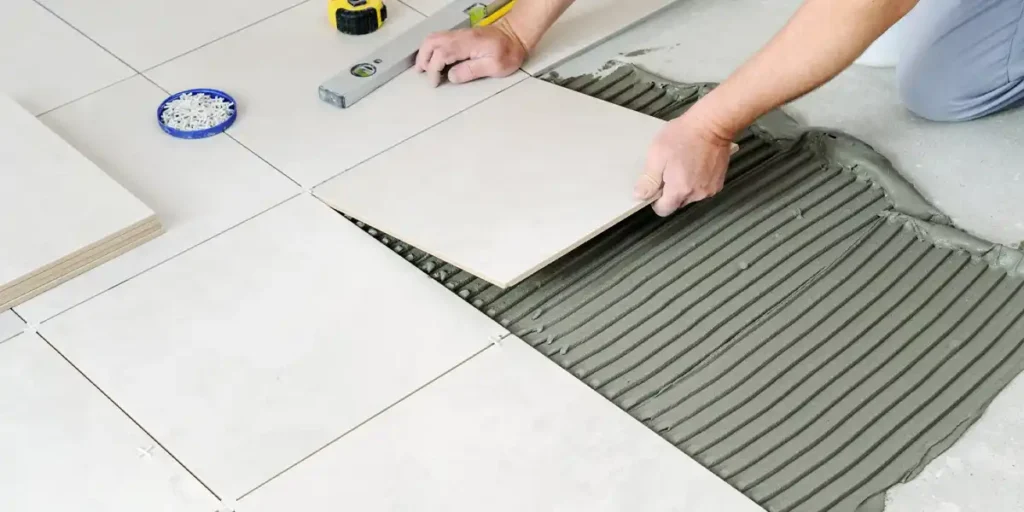Tired of outdated ceramic tiles but dreading the labor and cost of removal? You’re not alone. The good news is you can install new flooring right over your existing tiles.
This approach saves time, minimizes mess, and opens up endless design possibilities. In this guide, we’ll explore what type of flooring can be installed over ceramic tile and how to make the best choice for your needs.
Factors to weigh while choosing new floor
When choosing a new floor, it’s essential to weigh factors such as durability, aesthetics, and ease of installation. Here are the most popular options:
1. Luxury Vinyl Plank (LVP) and Luxury Vinyl Tile (LVT): Modern Versatility
Luxury vinyl is a top contender for its versatility and affordability.
Advantages:
- Waterproof: Perfect for bathrooms and kitchens.
- Style Variety: Available in wood, stone, and abstract finishes.
- DIY-Friendly: Click-lock systems make it easy to install.
- Thin Profile: Works well over existing tiles without raising floor height significantly.
Considerations:
- Durability: Although resistant to water, heavy furniture can cause dents.
- Thermal Changes: LVP may expand or contract in extreme temperatures.
2. Engineered Hardwood: A Touch of Elegance
For those who love the warmth and charm of wood, engineered hardwood offers an excellent balance between luxury and practicality.
Advantages:
- Durability: Resists wear and tear better than solid hardwood.
- Moisture Tolerance: More stable than traditional wood in humid areas.
- Timeless Appeal: Adds resale value and aesthetic elegance.
Considerations:
- Price: Higher upfront cost compared to vinyl or laminate.
- Professional Installation Recommended: Requires a level surface for the best results.
3. Laminate Flooring: Budget-Friendly and Stylish
Laminate mimics the appearance of wood and stone at a fraction of the cost.
Advantages:
- Affordability: One of the cheapest options for quality flooring.
- Scratch-Resistant: Suitable for homes with pets or children.
- Easy Maintenance: Requires little upkeep.
Considerations:
- Moisture Sensitivity: Not ideal for bathrooms.
- Realism: Some patterns may appear artificial compared to natural wood or stone.
4. Carpet Tiles: Soft and Customizable
For a cozy and noise-reducing option, carpet tiles are a practical choice.
Advantages:
- Warmth and Comfort: Ideal for bedrooms or living areas.
- Customizable Designs: Mix and match colors and patterns.
- Replaceability: Easy to replace individual tiles if damaged.
Considerations:
- Not Waterproof: Avoid using in damp areas.
- Allergen Concerns: May trap dust and allergens.
Preparing Your Ceramic Tile for New Flooring
Preparation is the cornerstone of any successful flooring project. Without the proper groundwork, even the best flooring materials may fail to meet expectations. Here’s a detailed breakdown to ensure your new flooring installation over ceramic tile goes smoothly.
Clean Thoroughly
Start by giving the existing ceramic tile a deep clean. Remove grease, dirt, and debris that may interfere with the adhesion of the new flooring. Use a strong degreasing cleaner or an alkaline-based cleaner to eliminate stubborn grime. A spotless surface not only ensures a smooth application but also prevents future issues such as bubbling or uneven patches.
Assess the Tile Condition
Inspect your tile for cracks, chips, or loose pieces. Damaged tiles can compromise the integrity of the new flooring. Repair minor cracks with tile adhesive or filler and replace any loose tiles. For more significant damage, consider whether the subfloor beneath the tile needs attention.
Address Uneven Surfaces
Uneven surfaces can lead to squeaky floors or visible imperfections in the final installation. Use a self-leveling compound to fill in low areas and ensure a flat base. For significant height discrepancies, you may need professional assistance to avoid complications with your new flooring.
Install Underlayment (If Needed)
Underlayment can provide added cushioning, noise reduction, and moisture resistance, depending on your chosen flooring type. For instance, luxury vinyl and laminate floors often benefit from a foam or cork underlayment, while engineered hardwood might require a specific moisture barrier. Always consult the manufacturer’s recommendations for compatibility.
Transitioning Seamlessly Between Flooring Types
When installing new flooring over ceramic tile, creating seamless transitions between rooms enhances the overall look and functionality.
Reducer Strips
Reducer strips are an excellent solution for height differences between the existing tile and new flooring. These strips create a gradual slope, minimizing tripping hazards while maintaining aesthetic appeal.
Inlay Strips
For a more decorative touch, use inlay strips made of metal, wood, or vinyl. These strips create a polished border that delineates spaces elegantly, making transitions visually appealing.
Matching Colors
Selecting similar hues for the tile and new flooring ensures visual cohesion. Neutral tones or complementary shades can blend the spaces harmoniously, enhancing your home’s overall design.
Final Thoughts
Replacing outdated ceramic tile doesn’t have to be a daunting task. By installing new flooring directly over the existing tiles, you save time, effort, and money. Whether you choose luxury vinyl, engineered hardwood, or laminate, the key to success lies in careful preparation and informed decision-making.
Transform your space with a stylish and durable tiling solution that fits your lifestyle and budget. Your dream flooring is just a project away! Contact Cardenas Flooring now.
FAQs
Can I install any type of flooring over ceramic tile?
Not all flooring types are suitable for installation over ceramic tile. Luxury vinyl, laminate, engineered hardwood, and carpet tiles are great options. Solid hardwood and other thick materials may require tile removal due to their need for a perfectly level surface. Always consult the manufacturer’s guidelines to ensure compatibility with the existing tile.
Do I need to level the ceramic tile before installing new flooring?
Yes, ensuring the ceramic tile surface is level is essential for proper installation. Uneven tiles or grout lines can create bumps or gaps in the new flooring. Use a self-leveling compound to smooth the surface, especially for materials like luxury vinyl or engineered hardwood that require a flat base for optimal performance.
How much does it cost to install new flooring over ceramic tile?
Costs depend on the flooring material, area size, and labor. Luxury vinyl costs $3–$7 per square foot, laminate is around $2–$6, and engineered hardwood ranges from $5–$15 per square foot. Additional expenses may include underlayment or leveling compound, which can add $1–$2 per square foot to the overall cost.
Can I install new flooring over damaged ceramic tiles?
It’s not recommended to install flooring over broken or loose ceramic tiles. These can compromise the stability of the new flooring. Repair damaged tiles or fill cracks before installation. For larger damage, consider replacing tiles or leveling the area with a self-leveling compound to create a stable foundation.
Will the new flooring raise the height of my floors significantly?
Yes, adding flooring over existing ceramic tiles can increase the floor height by a few millimeters to several inches, depending on the material and underlayment. Be mindful of height differences at doorways and transitions between rooms. Use transition strips or reducers to create smooth transitions and avoid tripping hazards.




